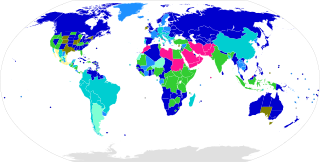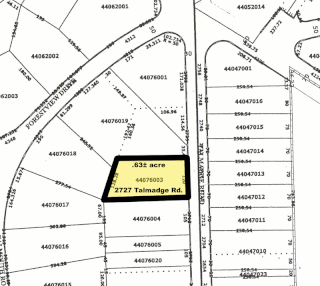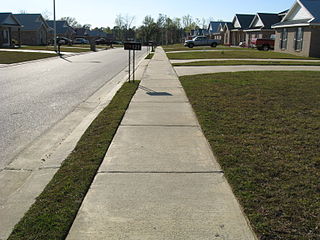Related Research Articles

The age of consent is the age at which a person is considered to be legally competent to consent to sexual acts. Consequently, an adult who engages in sexual activity with a person younger than the age of consent is unable to legally claim that the sexual activity was consensual, and such sexual activity may be considered child sexual abuse or statutory rape. The person below the minimum age is considered the victim, and their sex partner the offender, although some jurisdictions provide exceptions through "Romeo and Juliet laws" if one or both participants are underage, and are close in age.
Eminent domain, land acquisition, compulsory purchase, resumption, resumption/compulsory acquisition, or expropriation is the power of a state, provincial, or national government to take private property for public use. It does not include the power to take and transfer ownership of private property from one property owner to another private property owner without a valid public purpose. This power can be legislatively delegated by the state to municipalities, government subdivisions, or even to private persons or corporations, when they are authorized by the legislature to exercise the functions of public character.
A mortgage is a legal instrument of the common law which is used to create a security interest in real property held by a lender as a security for a debt, usually a mortgage loan. Hypothec is the corresponding term in civil law jurisdictions, albeit with a wider sense, as it also covers non-possessory lien.

In the United States, a plat (plan) is a cadastral map, drawn to scale, showing the divisions of a piece of land. United States General Land Office surveyors drafted township plats of Public Lands Surveys to show the distance and bearing between section corners, sometimes including topographic or vegetation information. City, town or village plats show subdivisions broken into blocks with streets and alleys. Further refinement often splits blocks into individual lots, usually for the purpose of selling the described lots; this has become known as subdivision.

Subdivisions are the act of dividing land into pieces that are easier to sell or otherwise develop, usually via a plat. The former single piece as a whole is then known as a subdivision. Subdivisions may be simple, involving only a single seller and buyer, or complex, involving large tracts of land divided into many smaller parcels. If it is used for housing it is typically known as a housing subdivision or housing development, although some developers tend to call these areas communities.
The Ontario Municipal Board (OMB) was an independent administrative board, operated as an adjudicative tribunal, in the province of Ontario, Canada. It heard applications and appeals on municipal and planning disputes, as well as other matters specified in provincial legislation. The tribunal reported to the Ministry of the Attorney General from 2012 until its shuttering. The Board had been criticized for its broad powers and authority to override the Planning Act decisions of municipal councils.

Deeds registration is a land management system whereby all important instruments which relate to the common law title to parcels of land are registered on a government-maintained register, to facilitate the transfer of title. The system had been used in some common law jurisdictions and continues to be used in some jurisdictions, including most of the United States.

The lot and block survey system is a method used in the United States and Canada to locate and identify land, particularly for lots in densely populated metropolitan areas, suburban areas and exurbs. It is sometimes referred to as the recorded plat survey system or the recorded map survey system.

Deseronto is a town in the Canadian province of Ontario, in Hastings County, located at the mouth of the Napanee River on the shore of the Bay of Quinte, on the northern side of Lake Ontario.
Mineral rights are property rights to exploit an area for the minerals it harbors. Mineral rights can be separate from property ownership. Mineral rights can refer to sedentary minerals that do not move below the Earth's surface or fluid minerals such as oil or natural gas. There are three major types of mineral property; unified estate, severed or split estate, and fractional ownership of minerals.
In law, severability refers to a provision in a contract or piece of legislation which states that if some of the terms are held to be illegal or otherwise unenforceable, the remainder should still apply. Sometimes, severability clauses will state that some provisions to the contract are so essential to the contract's purpose that if they are illegal or unenforceable, the contract as a whole will be voided. However, in many legal jurisdictions, a severability clause will not be applied if it changes the fundamental nature of the contract, and that instead the contract will be void; thus, often this is not explicitly stated in the severability clause.
In real estate, a lot or plot is a tract or parcel of land owned or meant to be owned by some owner(s). A plot is essentially considered a parcel of real property in some countries or immovable property in other countries. Possible owners of a plot can be one or more persons or another legal entity, such as a company, corporation, organization, government, or trust. A common form of ownership of a plot is called fee simple in some countries.

Lands administrative divisions of Australia are the cadastral divisions of Australia for the purposes of identification of land to ensure security of land ownership. Most states term these divisions as counties, parishes, hundreds, and other terms. The eastern states of Queensland, New South Wales, Victoria, and Tasmania were divided into counties and parishes in the 19th century, although the Tasmanian counties were renamed land districts in the 20th century. Parts of South Australia (south-east) and Western Australia (south-west) were similarly divided into counties, and there were also five counties in a small part of the Northern Territory. However South Australia has subdivisions of hundreds instead of parishes, along with the Northern Territory, which was part of South Australia when the hundreds were proclaimed. There were also formerly hundreds in Tasmania. There have been at least 600 counties, 544 hundreds and at least 15,692 parishes in Australia, but there are none of these units for most of the sparsely inhabited central and western parts of the country.
An easement is a nonpossessory right to use and/or enter onto the real property of another without possessing it. It is "best typified in the right of way which one landowner, A, may enjoy over the land of another, B". An easement is a property right and type of incorporeal property in itself at common law in most jurisdictions.

A contract is an agreement that specifies certain legally enforceable rights and obligations pertaining to two or more mutually agreeing parties. A contract typically involves the transfer of goods, services, money, or a promise to transfer any of those at a future date, and the activities and intentions of the parties entering into a contract may be referred to as contracting. In the event of a breach of contract, the injured party may seek judicial remedies such as damages or rescission. A binding agreement between actors in international law is known as a treaty.

The High Court of Justice in London, known properly as His Majesty's High Court of Justice in England, together with the Court of Appeal and the Crown Court, are the Senior Courts of England and Wales. Its name is abbreviated as EWHC for legal citation purposes.

The Custom of Paris was one of France's regional custumals of civil law. It was the law of the land in Paris and the surrounding region in the 16th–18th centuries and was applied to French overseas colonies, including New France. First written in 1507 and revised in 1580 and 1605, the Custom of Paris was a compilation and systematization of Renaissance-era customary law. Divided into 16 sections, it contained 362 articles concerning family and inheritance, property, and debt recovery. It was the main source of law in New France from the earliest settlement, but other provincial customs were sometimes invoked in the early period.

Williams v Hensman (1861) is an English trusts law case.
Eminent domain in the United States refers to the power of a state or the federal government to take private property for public use while requiring just compensation to be given to the original owner. It can be legislatively delegated by the state to municipalities, government subdivisions, or even to private persons or corporations, when they are authorized to exercise the functions of public character.
In Canada, judicial review is the process that allows courts to supervise administrative tribunals' exercise of their statutory powers. Judicial review of administrative action is only available for decisions made by a governmental or quasi-governmental authority. The process allows individuals to challenge state actions, and ensures that decisions made by administrative tribunals follow the rule of law. The practice is meant to ensure that powers delegated by government to boards and tribunals are not abused, and offers legal recourse when that power is misused, or the law is misapplied. Judicial review is meant to be a last resort for those seeking to redress a decision of an administrative decision maker.
References
- ↑ Makuch, Stanley; Craik, Neil; Leisk, Signe B. (2004). Canadian Municipal and Planning Law (2nd ed.). Toronto: Thomson Carswell. p. 224. ISBN 978-0-459-24135-3.
- ↑ "HM Land Registry plans: title plan (practice guide 40, supplement 5)". GOV.UK. Retrieved 2018-08-10.
- ↑ Rogers, Ian; Butler, Alison Scott (2005). Canadian Law of Planning and Zoning (2nd ed.). Toronto: Thomson Carswell. pp. 5–38. ISBN 978-0-459-31270-1.